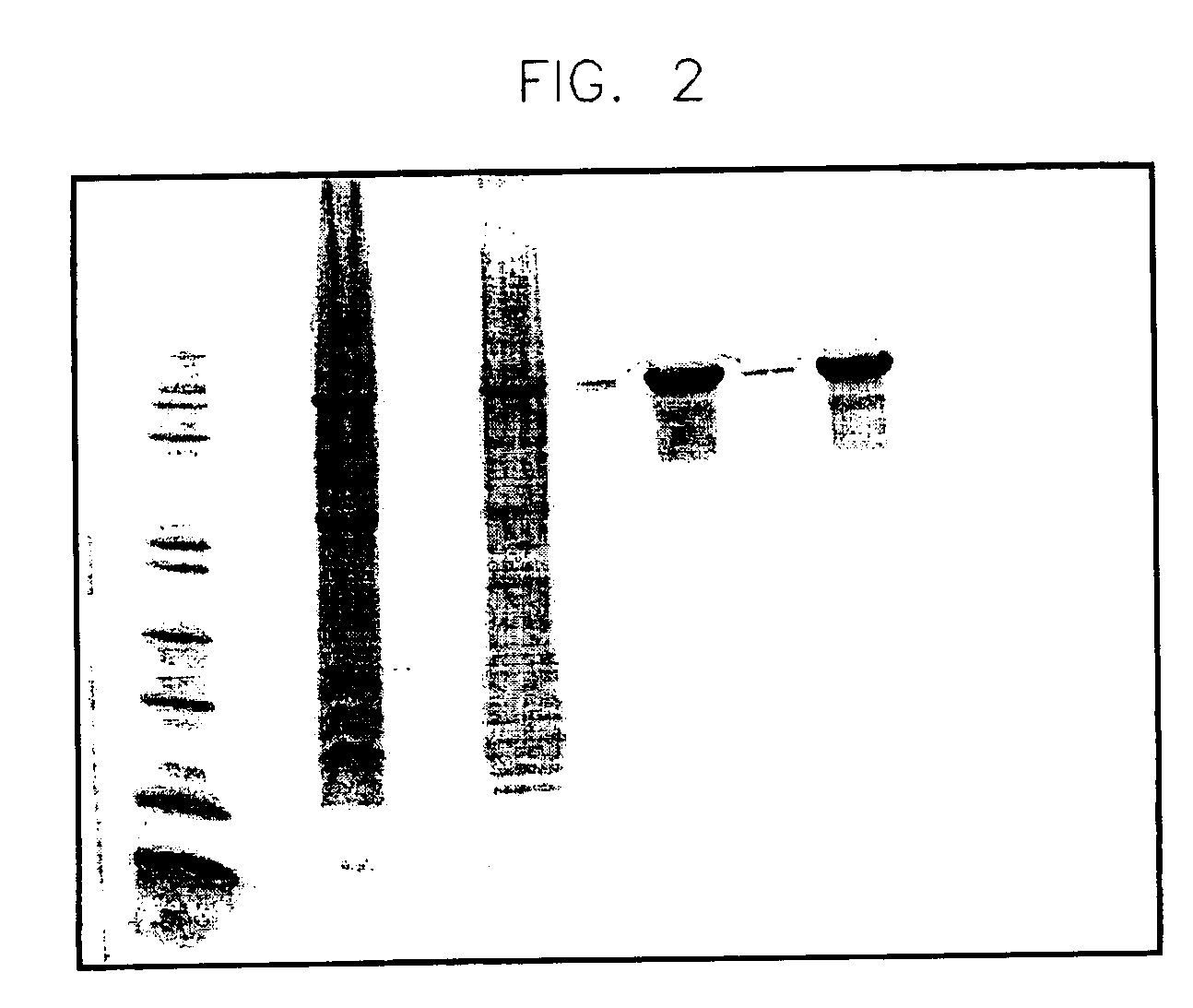Complexes comprising a prion protein and a peptidyl prolyl isomerase chaperone, and method for producing and using them
a technology of peptidyl prolyl isomerase and complexes, which is applied in the direction of peptides, drug compositions, metabolic disorders, etc., can solve the problems of no viral agent ever being convincingly demonstrated, no evidence of immunological response, and cattle deaths
- Summary
- Abstract
- Description
- Claims
- Application Information
AI Technical Summary
Problems solved by technology
Method used
Image
Examples
example 1
Construction of an Expression Plasmid Comprising Tandem-EcSlyD and hPrP(23-230)
[0130]On the basis of the pET24a expression plasmid of Novagen (Madison, Wis., USA) the following cloning steps were performed. The vector was digested with NdeI and XhoI and a semi-synthetic cassette comprising tandem-EcSlyD (amino acids 1 to 165,) and hPrP(23-230) was inserted:
[0131]This construct is simply referred to in the following text as SS-PrP. The insert of the resulting plasmid was sequenced (SEQ ID NO: 2) and found to encode the desired fusion protein (SEQ ID NO: 3), wherein the last 6 amino acids represent the hexa-His-tag derived from the expression system used. In this fusion protein the methionine in between the second linker and hPrP (23-230) and the amino acids LE at the end of hPrP have been introduced merely to facilitate cloning of hPrP (23-230).
example 2
Purification of the SS-hPrP (23-230) Fusion Protein
[0132]E. coli BL21(DE3) cells harboring the expression plasmid according to example 1 were grown in LB medium plus kanamycin to an OD600 of 1, and cytosolic overexpression was induced by adding isopropyl-β-D-thiogalactoside (IPTG) to a final concentration of 1 mM at a growth temperature of 37° C. 4 hours after induction, cells were harvested by centrifugation (20 min at 5000×g), frozen and stored at −20° C. For cell lysis, the frozen pellet was resuspended in 100 mM sodium phosphate pH 8.0, 7.0 M GuHCl, 10 mM imidazole at room temperature and the resulting suspension was stirred to complete cell lysis for two hours. After centrifugation and filtration, the lysate was applied to a Ni-NTA (nickel-nitrilo-triacetate) column pre-equilibrated in the aforementioned lysis buffer. After an intensive washing step (>20 column volumes of lysis buffer), the chaotropic lysis buffer was replaced by 50 mM sodium phosphate pH 7.8, 100 mM sodium chl...
example 3
UV-Spectroscopic Characterization of the Fusion Protein
[0133]Intriguingly, SS-hPrP(23-230) elutes as a soluble and native-like folded protein. The UV spectra of the recombinantly produced and matrix-refolded fusion protein do not indicate any aggregation tendency. As shown in FIG. 1, the baseline of the UV-absorption spectrum of SS-hPrp(23-230) in physiological buffer conditions almost equals the abscissa (beyond 310 nm), thus indicating that there are no light-straying particles resulting from self-association or aggregation phenomena.
[0134]Indeed, the shape of the spectrum depicted in FIG. 1 points to a soluble, easy-to-handle polypeptide fusion protein comprising hPrp(23-230). Thus the method described here facilitates the convenient recombinant production of a soluble form of the human prion protein in high amounts (yield>10 mg fusion protein / g wet weight) and in native-like conformation.
[0135]In contrast, PrP (23-230) alone displays a considerable aggregation tendency when refo...
PUM
| Property | Measurement | Unit |
|---|---|---|
| pH | aaaaa | aaaaa |
| pH | aaaaa | aaaaa |
| pH | aaaaa | aaaaa |
Abstract
Description
Claims
Application Information
 Login to View More
Login to View More - R&D
- Intellectual Property
- Life Sciences
- Materials
- Tech Scout
- Unparalleled Data Quality
- Higher Quality Content
- 60% Fewer Hallucinations
Browse by: Latest US Patents, China's latest patents, Technical Efficacy Thesaurus, Application Domain, Technology Topic, Popular Technical Reports.
© 2025 PatSnap. All rights reserved.Legal|Privacy policy|Modern Slavery Act Transparency Statement|Sitemap|About US| Contact US: help@patsnap.com



